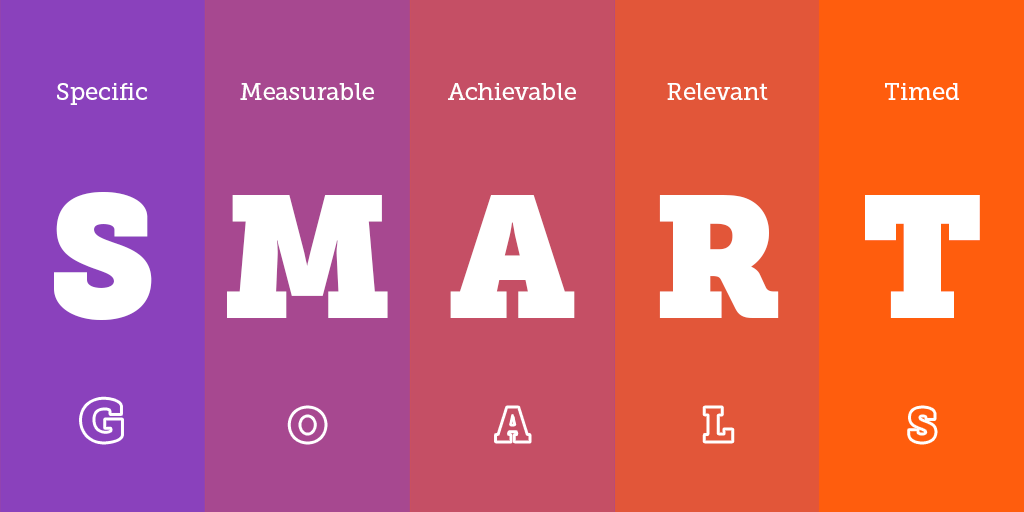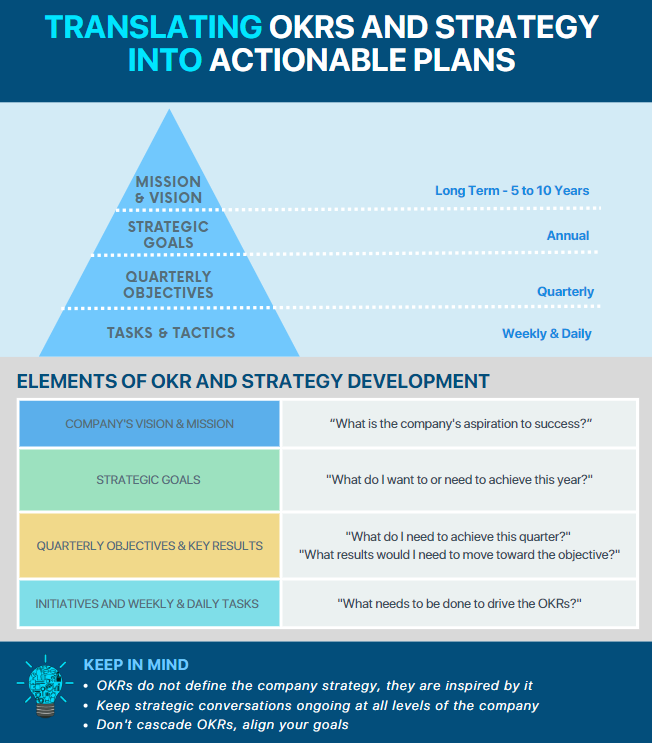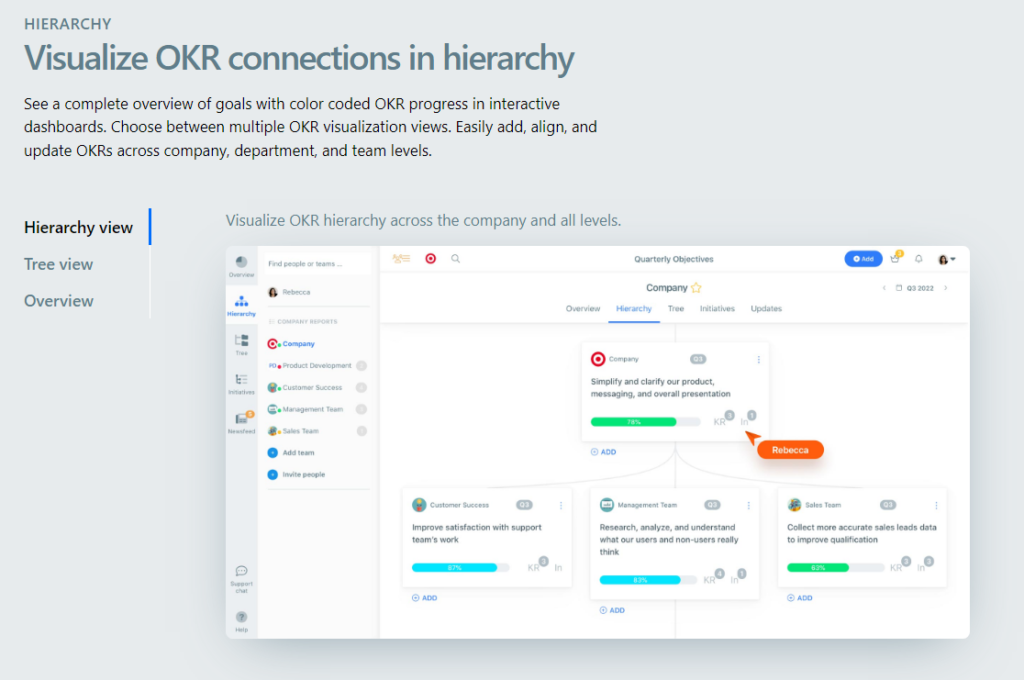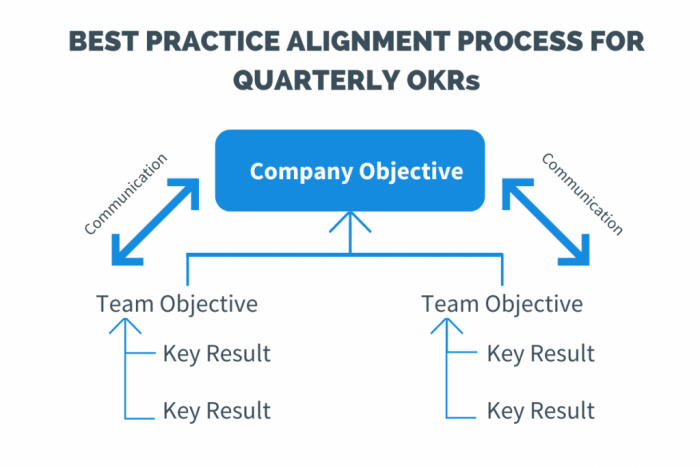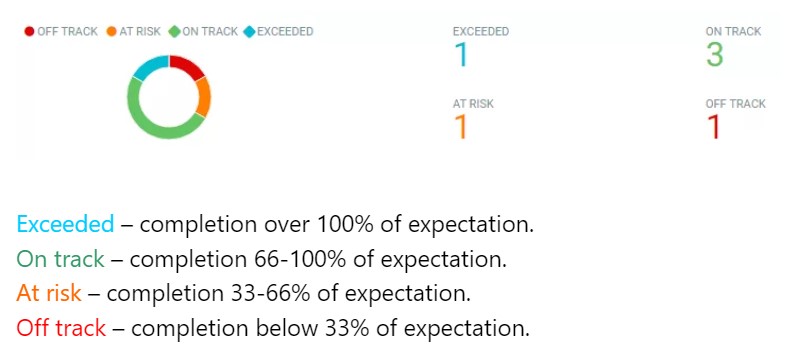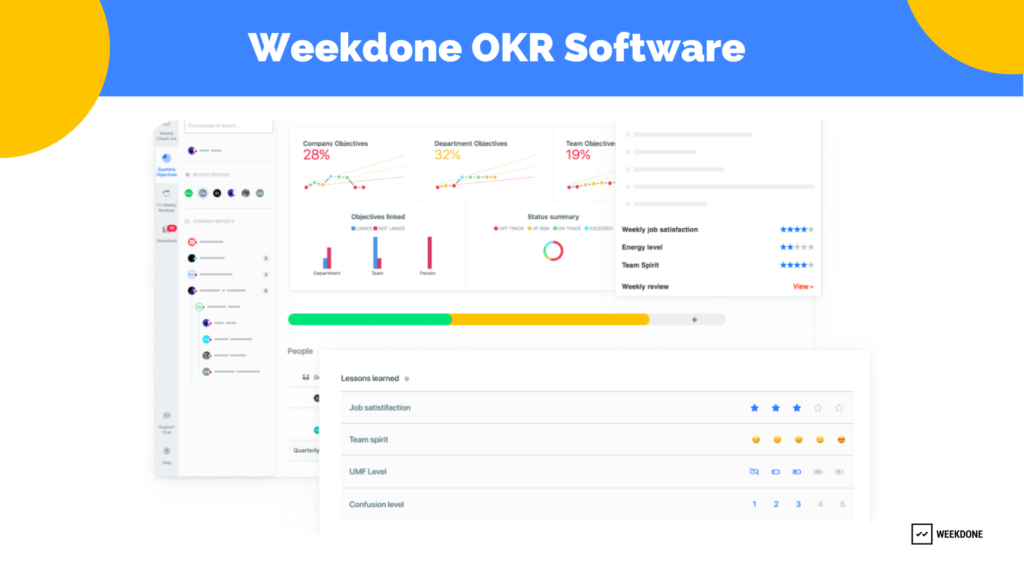Goal-setting is not about creating “safe” objectives and hoping to achieve 100% of goals. To improve business performance you need to inspire everyone in the organization by: sharing a clear strategy, setting “bold” goals, prioritizing objectives, and defining clear outcomes and key results.
Modern leaders, to keep up with the pace of business, need to translate strategy into plans with speed and agility. To stay agile, high-performing companies are shifting from setting five-year plans to creating quarterly goals.
A popular quarterly goal-setting framework is OKR (Objectives and Key Results) which enables setting objectives and defining outcome-driven key results to drive continuous improvement and growth.
The OKR method gives four learning cycles in the year, making it more effective to execute shifting strategic priorities and make improvements at the speed of business.
To maximize your chances of achieving your goals and to improve overall business performance, consider five OKR best practices covered in this article:
Have you created your company’s strategy? That’s a great start! Are you accurately tracking & assessing outcomes? Are they communicated to your teams and aligned to their objectives?
Find out how to set, track, and measure your goals in a dedicated OKR software to stay on track to your path to success.
5 OKR Best Practices to Improve Business Performance
1. Begin with Strategic Planning and Set Business Goals
Strategic planning is time-consuming and many companies spend days, weeks, or months to define goals. But the majority of them find it difficult to articulate what success means to them and the outcomes they expect to achieve.
When high-performing companies are focused on improving business performance, they typically begin the goal-setting process by creating and setting SMART goals.
Keep in mind that SMART goals should be:
- Specific – Clearly state what your company wants to achieve
- Measurable – Define key metrics to evaluate the success or failure of objectives
- Achievable – While goals need to be aspirational they should also be achievable with the resources and time available
- Relevant – Setting “safe” goals rarely deliver impact. Create goals relevant to your business to drive improvements, performance, and growth
- Timely – Determine a specific date to achieve your objectives and also assess and improve your short-term and long-term goals consistently
2. Focus on Strategic Alignment
To move toward success, strategic planning and goal setting need to be aligned. There is a “decay rate” of understanding strategic priorities and sometimes even those stakeholders who identify strategies cannot articulate their vision and mission statements.
Aligning and communicating business strategy can provide focus and motivation which can ultimately impact productivity and employee performance. Those employees who understand the company’s vision, mission, and strategy are more likely to be engaged and invested in the company’s overall purpose and strategic focus.
💡 One way to ensure strategic alignment is to break down your mission and strategy into quarterly objectives and weekly plans (+ measurable key results).
Read more, to find out how you can translate OKRs and strategies into actionable plans.
With changing business priorities your strategy needs to be communicated and executed in an agile manner. To facilitate this shift in strategy and ensure it is implemented across the company effectively, OKRs can consistently help drive the focus on what matters most.
👉 Watch this webinar to learn how you can execute your company strategy using OKRs
Have you created your company’s strategy? That’s a great start! Are you accurately tracking & assessing outcomes? Are they communicated to your teams and aligned to their objectives?
Find out how to set, track, and measure your goals in a dedicated OKR software to stay on track to your path to success.
3. Ensure Goal Alignment
While the first important step is creating a well-defined business strategy, to drive impactful change in your business, you need to align your goals and strategy across the company. Using a goal hierarchy view in the OKR framework you can connect the objectives and key results of different teams with your company’s goal.
When aligning goals, the best practice is to use a combination of a top-down and bottom-up approach and the OKR framework is a preferred methodology that facilitates strategic goal alignment.
Find out more about the best practices to align strategy, goals, and OKRs, and keep in mind the common mistakes to avoid.
👉 To better understand the key aspects of successful strategy execution and how OKR hierarchy can help align goals, watch this webinar.
4. Measure Outcomes to Drive Key Results
A common area most companies struggle with choosing the right metrics to measure success. An important factor for successful OKR implementation is defining the right outcomes that would drive the Key Results.
To track progress and success accurately, consider all the aspects of measuring outcomes – from the different types of measures such as leading and lagging indicators to how and what you are measuring.
💡 Listen in and learn how to measure your OKRs accurately. Watch this webinar
Have you created your company’s strategy? That’s a great start! Are you accurately tracking & assessing outcomes? Are they communicated to your teams and aligned to their objectives?
Find out how to set, track, and measure your goals in a dedicated OKR software to stay on track to your path to success.
5. Use Technology to Improve Operational Efficiency
Improving operational efficiency requires utilizing resources effectively, streamlining processes, and increasing productivity.
Adopting a goal-setting mindset of continuous improvement requires dedication and commitment from everyone involved – from the leadership teams to individual contributors.
The most effective and efficient way to improve operational efficiency is to utilize technology and tools. Adopting a dedicated OKR software can improve efficiency by accurately and consistently tracking progress, measuring success, and driving improvements.
OKR software can improve productivity by increasing employee engagement and motivating them to be more involved. With an overall view of goals, objectives, plans, and initiatives in one platform, it makes it easier to stay connected and on track toward achieving a common goal.
🎯 How can you nurture a mindset of continuous improvement? Make goal setting a practice not a chore. Connect your daily and weekly plans to your quarterly goals to add transparency.
